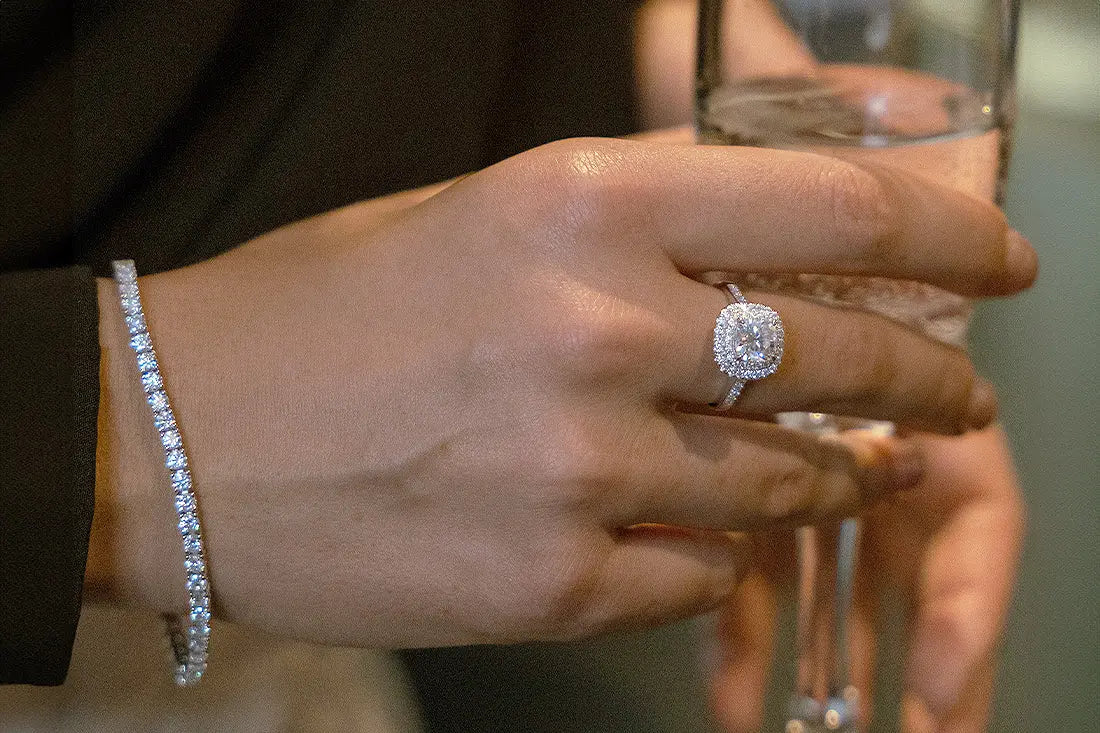Behind Their Sparkle
Do you wonder why Moissanite is gaining more popularity than diamonds? A rising number of people prefer moissanite rings and jewelry to diamonds for apparent reasons. It costs only a fraction of the diamond’s price, looks the replica of the diamond, and has more sparkle.
So, are you wondering what moissanite is made up of? Explore the process in detail and find out. But first, let us see what is moissanite and why it sparkles more than diamonds.
What is Moissanite?
Moissanite is a rare, tough, and durable stone used by the public as an alternative to diamond jewelry. It is silicon carbide, created in the laboratory, or can be naturally occurring.
Why Moissanite Sparkles More Than Diamonds?
Moissanite is a crystalline silicon carbide with a higher refractive index than diamond. This means that it bends light more effectively than diamonds. The excellent dispersion of white light falling on moissanite makes it more dazzling and brilliant than real diamonds.
For centuries together, people have been mistaking moissanite for diamonds. They are replicas of diamonds and have been used in engagement rings and luxury jewellery. However, these gemstones have become more friendly among the budget-conscious public who care about elegance. Ready to explore the lab process through which moissanite is created?
How Moissanite Was Discovered?
Moissanite has come a long way from being a modest lab-created gemstone to a jewel compared with a diamond. Its story began in 1893 when a French Scientist named Dr. Henri Moissan discovered microscopic Silicon Carbide (SIC) sparkling too brightly in the meteorite crater in Arizona.
The scientist was confused about it being a diamond as it sparkled as brightly as a diamond and had an exceptional hardness. When examined closely, the stone was found to be different. He found out that was made up of carbon and silicon. He named it Moissanite.
Naturally occurring moissanite is rare, found primarily in meteorites and other geographical creations. Hence, the problem with moissanite was that it was high in demand but rare.
Scientists decided to develop methods for preparing this gemstone in labs. The benefit attached to the moissanite was that it was as durable as a diamond, resistant to damage, and sparkled brighter than diamonds.
The Science Behind Moissanite's Brilliance
Moissanite is so highly regarded because of its exclusive optical properties. Moissanite has a higher refractive index (2.65-2.69) than diamonds (2.42). Hence, moissanite bends and reflects light more easily. This creates more extraordinary amount of sparkle and fire.
Since moissanite can disperse light into colours of a rainbow, it is a gemstone with extra brilliance. Moissanite is so known for its high refractive properties.
One of the key reasons moissanite is so highly regarded is its exceptional optical properties. It has a higher refractive index (2.65-2.69) than diamonds (2.42), which bends and reflects light more effectively, creating an extraordinary amount of fire and sparkle. This ability to disperse light into a rainbow of colors makes moissanite one of today's most dazzling gemstones.
Additionally, moissanite has a double refraction property, meaning light that enters the crystal is split into two rays. This contributes to its intense sparkle and gives it a unique visual appearance compared to diamonds.
How Moissanite Is Made: The Manufacturing Process
Creating high-quality moissanite involves advanced technology and precise scientific processes. Here’s a step-by-step look at how lab-grown moissanite is made:
How Are Silicon Carbide (SIC) Crystals Produced?
Moissanite comprises silicon carbide, which is primarily silicon and carbon. Natural diamonds are pure carbon; conversely, moissanite is a silicon carbide prepared in the lab using a complex chemical method.
Making of SIC Powder:
It is created by reacting silica with carbon at a very high temperature of over 2000 degrees Celsius. This is done in an electric resistance furnace. This reaction creates small grains of silicon carbide that are then purified and grown into crystals.
Crystal Growth:
The purified form of SIC is then put on at a temperature and pressure that promotes the growth of the crystals. This process is slow and takes several weeks to grow more prominent, and when it becomes a single crystal-like structure, it is finally cut into gemstones.
Cutting the Gem:
Once they are grown to their full size, silicon carbide crystals are formed. They are cut carefully and faceted to get the maximum sparkle and brilliance. Precise angles are cut with the help of the latest diamond-tipped tools. They are polished finally to obtain more brilliance.
Quality Control and Grading:
Each of the moissanite undergoes a rigorous quality control process. This ensures that they meet the demanded standards. They are evaluated for color, brilliance, hardness, clarity, etc.
Additional Treatment Process:
Moissanite undergoes additional treatment but in some cases only to improve the way they look. It includes color corrections. Some of the moissanites are treated to give them a colorless appearance.



